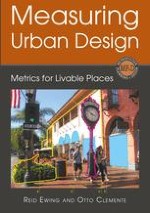What makes strolling down a particular street enjoyable? The authors of Measuring Urban Design argue it's not an idle question. Inviting streets are the centerpiece of thriving, sustainable communities, but it can be difficult to pinpoint the precise design elements that make an area appealing. This accessible guide removes the mystery, providing clear methods to assess urban design.
The book provides operational definitions and measurement protocols of five intangible qualities of urban design, specifically: imageability, visual enclosure, human scale, transparency, and complexity. The result is a reliable field survey instrument grounded in constructs from architecture, urban design, and planning. Readers will also find illustrated, step-by-step instructions to use the instrument and a scoring sheet for easy calculation of urban design quality scores.
